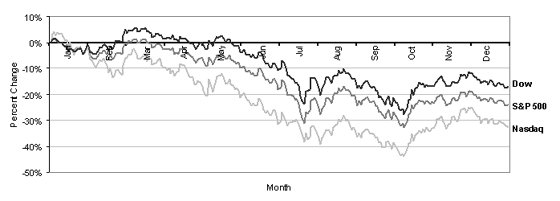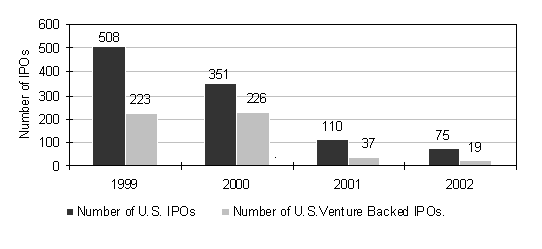|
|
| Home - Software M&A Review - Feb 03 Issue |
Software M&A: 2002 - A Year in Review |
Ken Bender & Allen Cinzori, Software Equity Group
The year after the 9/11 tragedy was difficult for both publicly traded and early stage enterprise software companies alike. The following is a complete review and analysis of the software equity markets in 2002, including private equity deals, M&A, and general economic factors.
ECONOMY
A threatened war with Iraq, continuing concerns about domestic security, sharply reduced corporate spending, public company accounting scandals and increased unemployment, all took their toll on the economy in 2002. Businesses largely hunkered down, leaving consumers, who account for roughly 2/3rds of U.S. Gross Domestic Product (GDP), at the helm. Forty-year-low mortgage rates and zero interest rates provided much of the incentive for consumers to push real GDP upward 3%. Recent indications of weakening consumer confidence have raised some concern, but analystsí project continued resilience from consumers as income growth and tax cuts offset increased personal debt and escalating energy prices.
On the business front, capital investment declined precipitously as businesses focused on cutting overhead, shedding excess inventory and eliminating non-core operations. That said, many sectors now appear to have worked through their issues, and year-end reports show improvements in earnings and fewer workers laid off. Other encouraging signs: By the end of 2002 temporary staffing agencies added 14,000 workers to the workforce, and the manufacturing workweek grew by 0.3 hours, measures which are often precursors to stronger employment trends.
Overall, the US economy appears somewhat stronger today than it did a year ago, but remains on fragile ground, vulnerable to a host of economic and geopolitical threats.
CAPITAL MARKETS
U.S. markets ended the year on an upswing, with the Dow, Nasdaq and S&P 500 climbing 7.5%, 8.3% and 5.6%. For the year, these same indices were down 17.2%, 32.5% and 23.8% (see Figure 1).
While the broader market indices showed improvement in the fourth quarter, the software industry remained flat relative to the third quarter. The median price to revenue multiple for the SEG Sixty, our software industry public company index, was 1.5x (see Figure 2). The average was 2.0x, with 80% between 1.8x and 2.3x. When compared to the first quarter, the median revenue multiple declined 54.8%. The fourth quarter median price to earnings ratio was 30.5x.
Figure 1: 2002 Performance of Stock Market Indices

Not surprisingly, providers of security software faired the best during the fourth quarter. The median price to revenue multiple within this sector grew 19.1% to 3.0x. The information/data management sector increased 6.1% to 1.7x. Customer relationship management (CRM) and enterprise application integration (EAI) businesses were hit the hardest, falling 26.9% to 1.1x and 23.8% to 1.2x, respectively. Conservative IT expenditures continued to characterize enterprise spending in the fourth quarter, with CIOís favoring high priority solutions with an identifiable short-term ROI.
Figure 2: Software Industry Median Multiples by Sector

For 2003, Goldman Sachs projects 5% growth in enterprise IT spending with the majority spent on security, wireless LAN connectivity, Windows OS and storage management. EAI, network management software and supply chain management are also expected to increase.
INITIAL PUBLIC OFFERINGS
Initial public offering (IPO) activity declined further in 2002, as would-be candidates eschewed the weak and volatile public markets. IPOs fell to a two decade low to seventy-five, raising an aggregate $22.6B, the lowest dollar amount since the early 90ís.
Healthcare led the IPO market with the largest number of offerings, at seventeen. The telecomm sector, which saw one-hundred-eleven in 2000 and five in 2001, had none. Only five software companies went public in 2002, and as a group lost an average 26% of their offering price by year-end.
Figure 3: U.S. Initial Public Offerings

Among the software companies that braved the IPO market, Altiris, a provider of corporate and IT asset management software, and Verint Systems, a provider of analytic software for communications interception, video surveillance and business intelligence, saw their stock prices hold up well. At year-end, Altiris and Verint were up 47% and 27%, respectively, from their offering price. Plumtree and Printcafe were not so fortunate. Corporate portal software provider Plumtree fell 60% and Printcafe, which provides printing industry supply chain software solutions, declined 89%.
|
|


|

